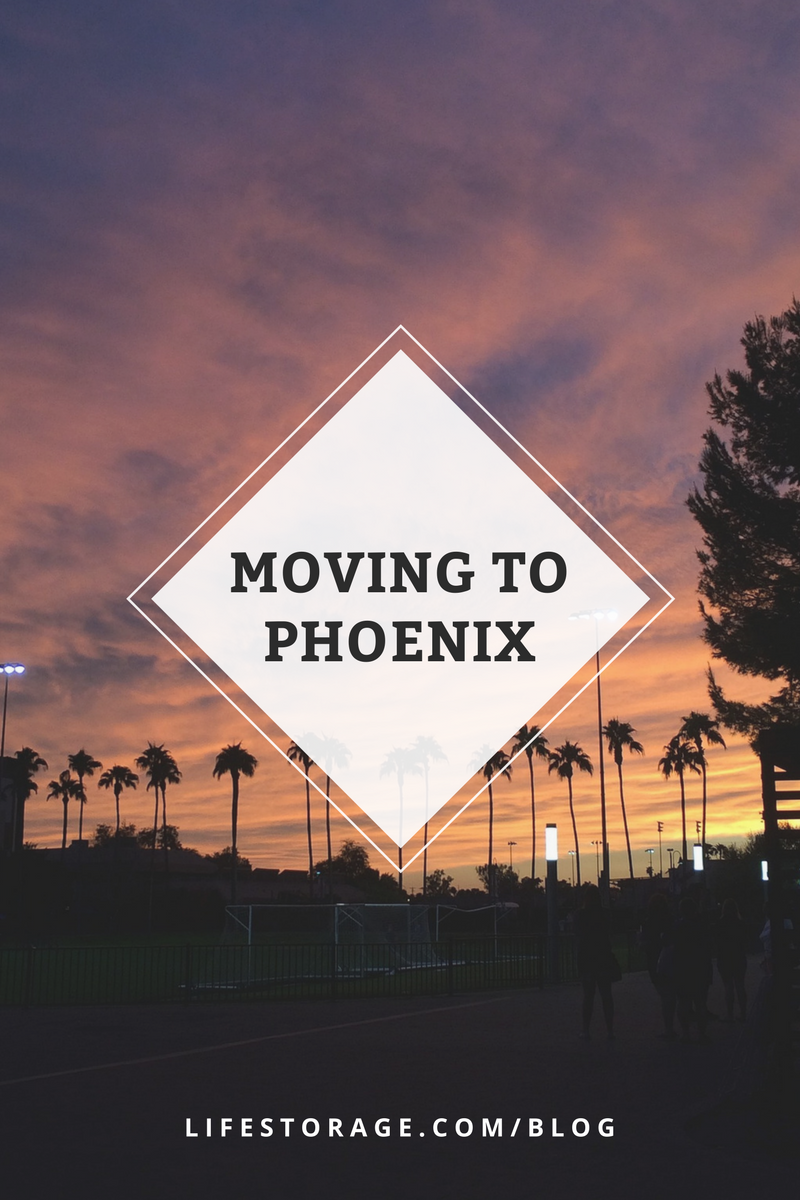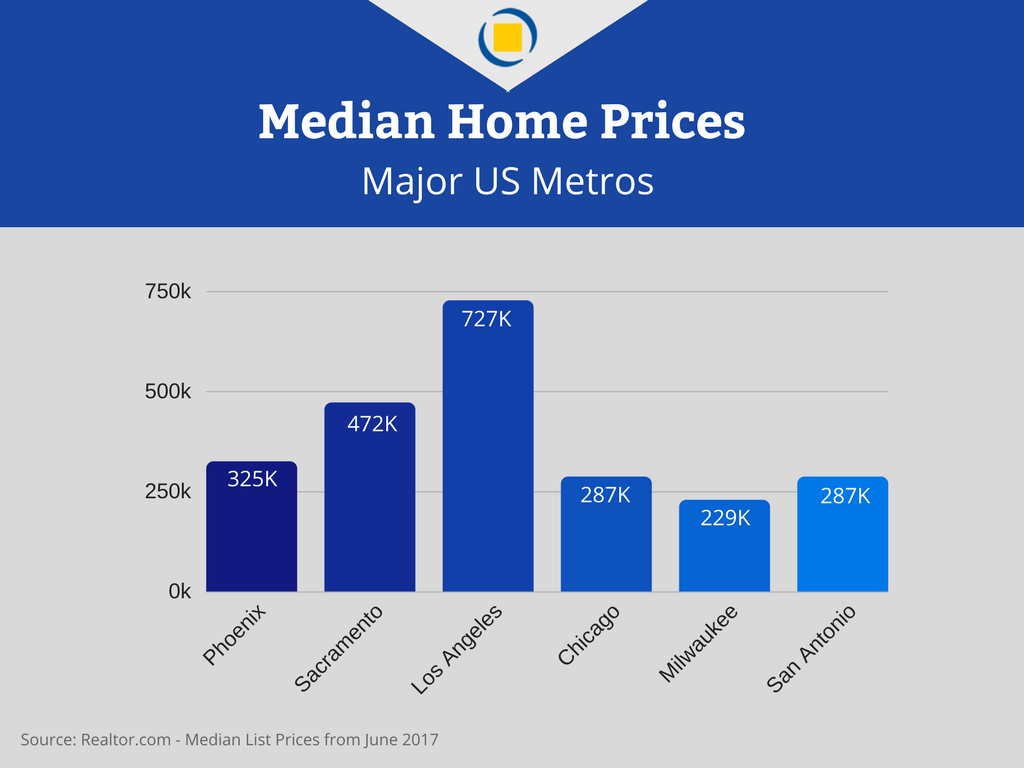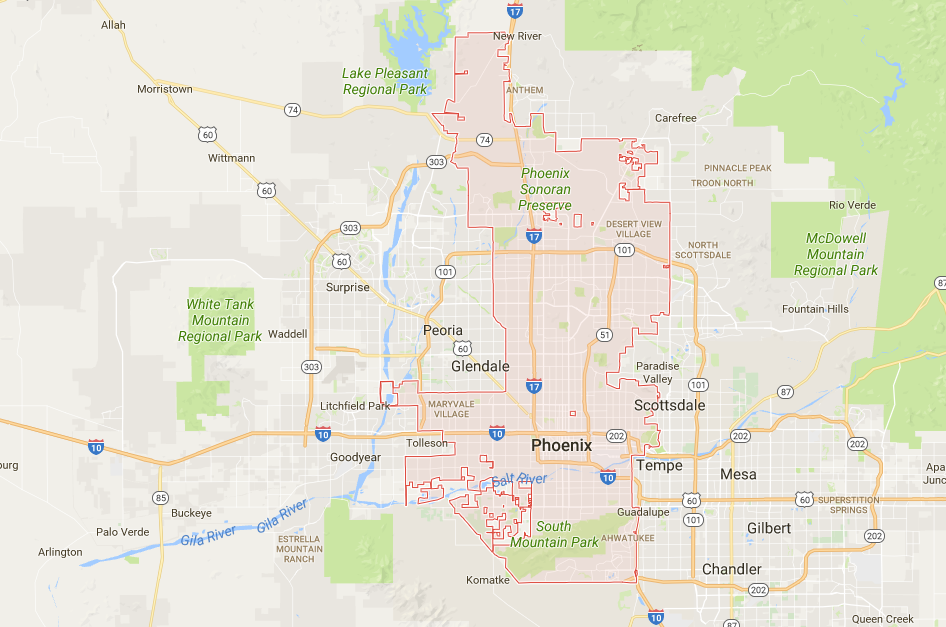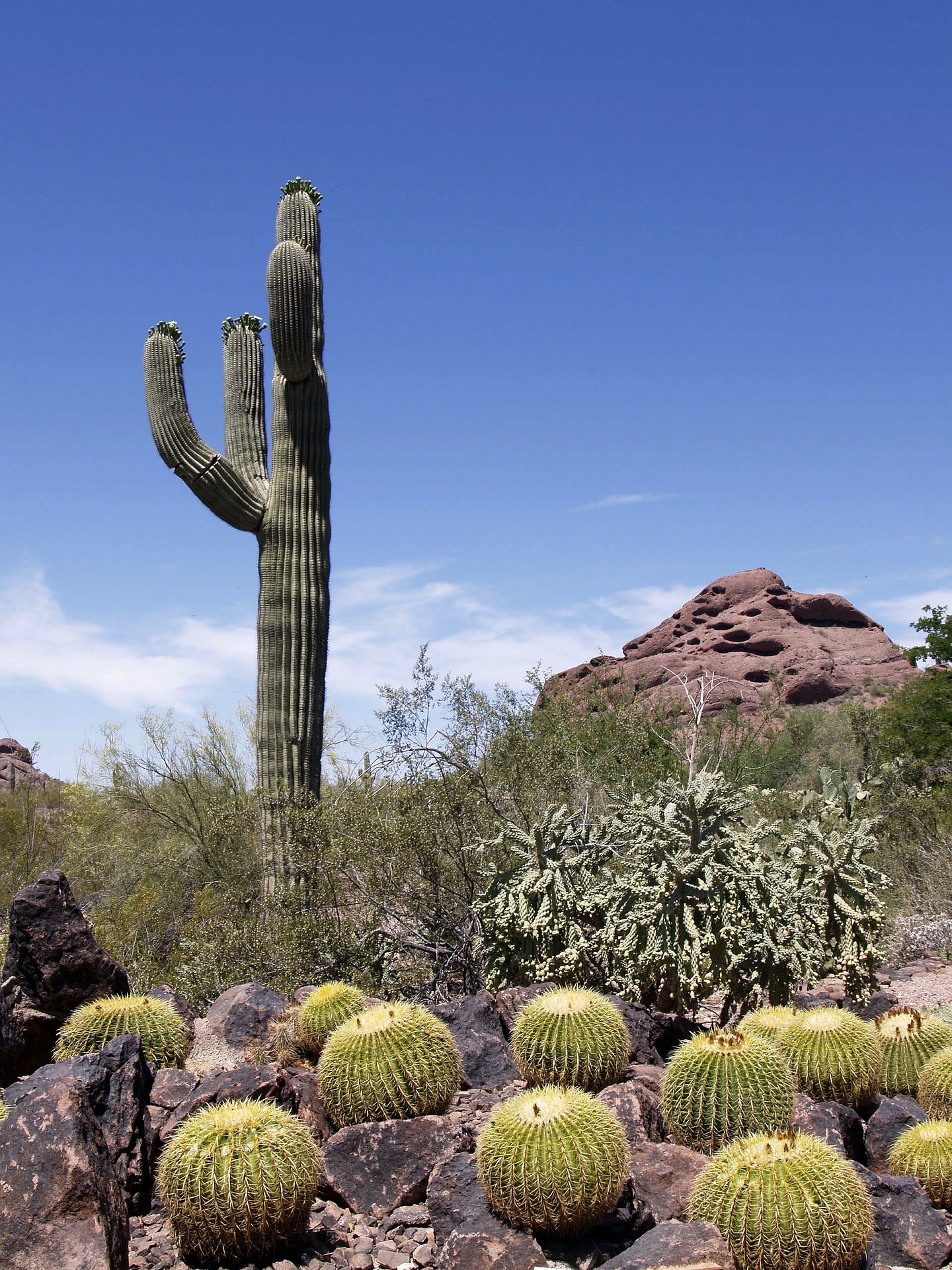
Is Phoenix a good place to live? It’s certainly an ideal place to visit. More than 16 million people travel to metro Phoenix every year. In fact, a good number of those tourists become residents, which helps solidify the area as a city of transplants. Moving to Phoenix was a deliberate choice for many of its 1.6 million inhabitants, and you’ll be hard pressed to find a ton of native Phoenicians that grew up in the area.
So why do people move here? Could it be the low taxes? Or the proximity to big attractions like Las Vegas and the Grand Canyon? Perhaps it’s the lack of a winter and the wide variety of things to do. Phoenix is diverse and is packed with influences from many walks of life, from Native American, Latin American and even Wild West culture.
Regardless of what brings you to the area, we’re here to explore if moving to Phoenix is the right choice for you. In this guide, we’ll give you an overview of some pros and cons, discuss where to live and even help you find a job.
Table of Contents:

What to Expect Living in Phoenix
Living in Phoenix can take some getting used to, wherever you’re relocating from. Arizona is one of the few states that does not recognize daylight savings time and instead goes by Mountain Standard Time all year round. It’s very easy to grow citrus trees here, and the sunsets are some of the most vibrant in the country.
But not everything in Phoenix is a walk in the park. Scorpions, rattlesnakes and coyotes are all regular inhabitants of the Phoenix metro area. And while it’s made strides in recent years, the public transportation doesn’t cover the entire city. And it’s hot. Really hot. Phoenix’s summertime temps rise to the 110s.
Here are some factors you’ll want to explore before you decide to move to Phoenix:
Transportation

If you’re hoping to move to Phoenix without a car, think again. There is a light rail and a bus systems in place, but both are limited in size and overall reach.
Biking to work is a possibility if you live in the city. The Bicycle Boulevard is a 4.6 mile stretch of bike lane that helps cyclists commute safely throughout the Downtown Phoenix area.
When compared to large cities like Los Angeles, California, commute times aren’t terrible. Getting around in Phoenix by car is relatively easy because the streets are laid out in an easy-to-navigate grid system.
If you notice more congestion on the interstate during the winter, you can thank the many snowbirds that call Phoenix home between the months of November and February.
Weather
Phoenix is widely known as the Valley of the Sun. It’s located in the Sonoran Desert, the warmest desert in North America.
If you’re moving to Phoenix, Arizona be ready to embrace the heat and make sure you’re prepared. Average highs and lows (degrees Fahrenheit), according to Weather.com in Phoenix are:
- January 67/46
- February 71/49
- March 77/54
- April 85/60
- May 95/69
- June 104/78
- July 106/84
- August 105/83
- September 100/77
- October 89/65
- November 76/53
- December 66/45
Some hot weather tips to keep in mind include:
- If possible, try to park your car in the shade.
- Don’t immediately touch a steering wheel or leather seats with bare skin without cooling down the interior of your car first.
- Never leave pets or children in your car unattended. This is required all year round, but it is especially dangerous to do in the summer.
- Don’t leave your phone in the sun because it will overheat and shut off.
- Stay hydrated! Some say to drink half your body weight in fluids; others recommend eight glasses of water a day. Whatever the amount, just make sure you’re drinking enough for you.
- Don’t throw out all your winter clothes. When the summer heat finally passes, anything below 70 degrees is going to feel extremely cold.
If the heat is not for you, but you still wish to move close by, consider this. Flagstaff is about two hours north of Phoenix, and it can be up to 20 degrees cooler.
Weather patterns to watch out for are monsoons and seasonal dust storms called haboobs. Phoenix encounters about three of these storms annually. Monsoon season brings downpours of rain to the Phoenix metro during the summer season. These storms develop abruptly and are known to cause flash flooding and road hazards; residents and tourists are encouraged to stay off the roads and in a safe place until the storms pass.
With the exception of excessively warm summer months, Phoenix weather is consistently pleasant throughout the year.
Cost of Living – Phoenix vs. Other Areas

Living in Phoenix is significantly more affordable than places like Los Angeles and Sacramento, California. Overall, the cost of living in Phoenix is 5 percent lower than the national average, according to Payscale.
For retirees who live on a fixed income, moving to Phoenix can be ideal due to the reasonable cost of living balanced with a number of amenities available. Property taxes are low compared to other large cities, but unlike retiree destinations in Orlando, you will have to pay Arizona state income tax. Arizona also has a vehicle tax you pay when you register and when you renew your registration on your vehicle.
Even though home prices are on a steady incline after the housing market collapse around 2010, property values still fall well below comparable areas in California and are just slightly above the national average.
Jobs in Phoenix
When it comes to technology, Phoenix, Arizona, is one of the fastest-growing and most dynamic regions in the country and is widely considered a hub for technology and software companies. Operational costs are up to 42 percent less than California, according to the Greater Phoenix Economic Council.
Government officials and organizations do everything in their power to lure more technology opportunities to Metro Phoenix which has led to an uptick in tech jobs. Recently, technology companies like Uber, Yelp and Shutterfly have opened offices in the Greater Phoenix area, and Amazon has a fulfillment center there.
Best Places to Live in Phoenix

Phoenix is the largest city in the state of Arizona and the sixth most populous city in the US. The city and its surrounding areas are often referred to as Metro Phoenix or Salt River Valley and have an estimated 4.5 million residents.
The metro is positioned inside of Maricopa and Pinal Counties and ranks as one of the largest metro areas in the country. It’s also one of the fastest-growing in the United States. Maricopa County shows significant population growth with an average of 222 people moving to the county every day, according to Census.gov.
We picked a handful of city neighborhoods and suburban areas to help you get an idea of what moving to Phoenix might look like for you. As always, figure out your priorities and narrow down your search based on what’s important to you and your family.

City Neighborhoods
In recent years the Downtown Phoenix area has experienced a renaissance. Now some of the best neighborhoods in Phoenix are located here. Restaurants, art galleries, shops and businesses have moved in, which has spurred a series of new developments, ranging from apartment complexes to new hotels and high-rises.
Communities Near Downtown Phoenix
- Roosevelt Row — RoRo is pedestrian-friendly, and is known for its award-winning restaurants, coffee shops, locally-owned boutiques, art galleries, and monthly First Friday events that bring out thousands of locals. Roosevelt Row is one of the oldest arts districts in the city and it has undergone intense revitalization, making it a highly desired place to live.
- Grand — Positioned northwest of the downtown core, Grand is one of the most bike-friendly in all of downtown Phoenix. There are converted warehouses painted with colorful murals and lots of art gallery spaces in this eclectic, hip neighborhood.
- Greater Coronado — This historic neighborhood is comprised of three districts – Brentwood, Coronado and Country Club Park. Bungalow, Spanish Colonial Revival and ranch-style homes are found throughout, which means there’s no lack of charm. The neighborhood is located in midtown Phoenix and is in close proximity to the freeway and the downtown area, which makes it great for working commuters.
- Arcadia — This established neighborhood is quite possibly the most desired in the greater metro area. Not only are there great views of Camelback Mountain, but Arcadia is also home to some of the most mature citrus trees and greenery in all of Phoenix. And it’s just a short distance from shopping in downtown Scottsdale and nightlife in downtown Phoenix.
Phoenix Suburbs
These four suburbs offer proximity to the city but also have the draw of suburban amenities, making them some of the best places to live in Phoenix.
- Mesa — Located just 15 miles east of Phoenix, the city of Mesa is the third-largest city in Arizona. Living in Mesa will give you the benefit of living in a growing metropolitan while still maintaining a distinctly suburban feel. Plus, Mesa is a short distance from a number of outdoor recreation activities, from hiking at the Superstition Mountains to kayaking and paddleboarding along the Salt River.
- Tempe — The city of Tempe is home to over 160,000 residents and is located in the East Valley. Tempe is also a bustling college town. It’s home to Arizona State University, one of the largest universities in the country.
- Gilbert — This rapidly growing East Valley suburb has a small town appeal. The downtown Gilbert area is home to many popular restaurants and each weekend hundreds of residents come to shop the recurring outdoor farmers market for locally-grown produce and artisan goodies.
- Glendale — The West Valley suburb is located about nine miles outside of Downtown Phoenix and is home to over 225,000 residents. Glendale has dubbed itself “Arizona’s Antique Capital,” making it an ideal destination for history lovers, as well as sports fans alike. The Arizona Coyotes and Arizona Cardinals both play in Glendale.
K-12 and Higher Education in Phoenix
Phoenix is home to 30 school districts. Within these districts there are 325 public schools and more than 200 private and charter schools. Each district has its own system and leadership as well as differing quality scores.
There are also a handful of higher education opportunities throughout Metro Phoenix. Arizona State University has campuses in Glendale, Mesa, Downtown Phoenix, and its main campus in Tempe. Downtown Phoenix is also home to The University of Arizona College of Medicine. And Grand Canyon University, the largest Christian university in the world, offers more than 200 academic programs in the Phoenix area.
Things to Do in Phoenix

Despite the heat, there are so many fun things to do in Arizona. Phoenix is home to some incredible attractions, outdoor adventures and cultural experiences that draw in more than 16 million tourists a year. If you’re moving to Phoenix, make like a tourist and explore any of the following Phoenix attractions. During the off-seasons, many resorts and tourist attractions offer deals for Phoenix-area residents. We may have invented the phrase, “stay-cation”!
Top Area Attractions
- Phoenix Zoo — Since its opening in 1962, the Phoenix Zoo has welcomed more than 43 million visitors. Making a trip here is more than just admiring some exotic animals. The Phoenix Zoo aims to inspire its guests to care more for the natural world. In keeping with that promise, the Phoenix Zoo is world-renowned for its contributions to conservation science.
- Desert Botanical Garden — Every desert plant found in the Desert Botanical Garden has been adapted to thrive in harsh conditions. DBG’s hope is to educate its visitors about sustainability and preserving the desert landscape through the example they set. The garden also hosts events throughout the year, ranging from art exhibits and live music performances, to food festivals and holiday celebrations.
- Arizona Science Center — Science has a way of captivating people of all ages. The Arizona Science Center’s goal is to provide access to science based on the present demands of the community. Everyone is encouraged to visit the recently launched CREATE Makerspace center and start building and innovating. The Arizona Science Center also has programming for adults that includes craft beer, cocktails, and laser shows coordinated to hit music.
- Butterfly Wonderland — Butterfly wonderland gives visitors the opportunity to experience what it’s like to visit the rain forest, without ever leaving the desert. The conservatory houses more than 3,000 fluttering butterflies.
- OdySea Aquarium — The desert meets the ocean at OdySea Aquarium. More than 6,000 animals call OdySea home and there are over 65 exhibits to explore. The Scottsdale aquarium presents interactive, entertaining, educational experiences for guests of all ages.
- Need more? A two hour drive north will get you to ski destinations and less than six hours in the car will get you to San Diego or Los Angeles.
Where to Go Outdoors
In Phoenix there are more than 180 city parks and over 33,000 acres of desert preserves. Hikers, trail runners and mountain bikers can find their sanctuary on over 200 miles of designated desert trails. It won’t take long to find your favorite outdoor oasis, but here’s where you can start your search.
- South Mountain Park and Preserve — With over 16,000 acres, this preserve is home to three mountain ranges. It’s one of the largest municipally maintained parks in the nation, larger than New York’s Central Park. Travel 2,330-feet up to access the highest publicly accessible peak at Dobbins Lookout. This scenic lookout is also accessible by car.
- Salt River Tubing — Quirky website aside, Salt River Tubing is what you do when you want a relaxing day beneath the mountains as opposed to a rigorous day climbing up them. Float trip times range between two and five hours.
- Ak-Chin Pavilion — If you want to be outdoors without all the exercise, visit the scenic outdoor amphitheater and listen to your favorite bands live. With lawn seating accommodating 12,000 people, lots of the major musical acts and festivals stop here.
Phoenix’s Papago Park, Camelback Mountain, and Piestewa Peak are also popular hiking destinations.
Popular annual events in Phoenix
From music festivals to foodie events, Phoenix has all that, and more.
- McDowell Mountain Music Festival — Every March this locally grown music festival sets up in Phoenix’s Hance Park for a weekend of music, art, food, and entertainment. Plus, proceeds from the music fest benefits local non-profits and go back into the Phoenix community.
- Devour Phoenix — Taking place at the Desert Botanical Garden, this award-winning, multi-day food festival features the best culinary starts across the state of Arizona and around Phoenix.
- Phoenix Film Festival — Each spring the Phoenix Film Festival celebrates the latest and greatest in film. Movie geeks can see films from a series of genres, from sci-fi and horror to documentary films and indie flicks.
- Phoenix Flea — This unique flea market experience brings out antique lovers and treasure hunters each spring and each fall. The Phoenix Flea champions small business owners and more than 150 vendors and artisans set up shop at the event.
Where to Eat
For a time, Phoenix had a less than thriving food scene. All that has changed. Areas that were once ghost towns less than a decade ago are now booming with creative eateries and craft beers.
Given the geographical location, it’s no surprise that much of the cuisine has a Southwestern, Mexican, and Native American flare.Phoenix offers an array of cuisines, many of which are inspired by the cultures found throughout the Southwest and south of the border.
Grab a bite at some of these acclaimed eateries after a bit of house hunting:
- Matt’s Big Breakfast — With locations across the Valley of the Sun, classic breakfast is always in reach
- Barrio Cafe — Mexican cafe with dozens of accolades
- Stockyards Restaurant — Proclaimed “Arizona’s Original Steakhouse”
- Short Leash Hotdogs — Gourmet hotdogs served on naan bread
- Phoenix Public Market Cafe — Order at the counter with a menu brimming with local ingredients
- Gallo Blanco — Destination for Mexican breakfast, tacos, and happy hour
Sporting Events
The Valley of the Sun is home to more than 200 golf courses and hosts the largest PGA event annually, The Waste Management Phoenix Open. Other notable sporting events include Cactus League Spring Training, College Football’s Playstation Fiesta Bowl, College Football’s Cheez-It Bowl, and NASCAR events.
Phoenix is also one of the few cities to have professional sports teams in all major sports, they include:
- Arizona Cardinals — NFL
- Phoenix Suns — NBA
- Phoenix Mercury — WNBA
- Arizona Coyotes — NHL
- Arizona Diamondbacks — MLB
- Phoenix Rising — USL

Moving to Phoenix – Tips for New Residents
When moving to any new city, you’ll have to learn to roll with the punches and accept that you might love some things about Phoenix, but you might not like others. We’ve got some relocation tips to keep in mind for anyone heading to the Valley of the Sun.
- If you’re relocating from out of state, don’t forget to apply for an Arizona state driver’s license once you move. Also, register your vehicle at the DMV.
- Figure out when garbage day is in your Phoenix neighborhood.
- Many properties in Phoenix lack basements to store outdoor gear or holiday decorations, and garages aren’t typically temperature controlled. You may want to consider renting cheap self storage in Phoenix to help with your storage needs.
Editor’s Note: This post was originally published on July 28, 2017, and was revised on November 1, 2019, with new information from Phoenix expert, Lauren Topor.







